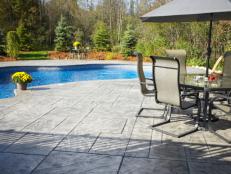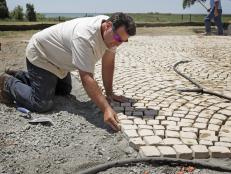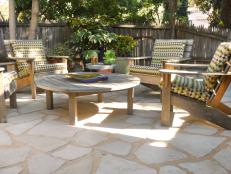Concrete Patios Gaining a Stamp of Approval
Take a look at any home-design magazine and you'll see growing evidence of concrete's newly gained respect as a decorating element in floors, counters and other applications. Now landscapers are taking a new look at using this age-old material outdoors, using a stamping process to create patios that look like natural slate or fieldstone at a fraction of the price these high-end materials typically carry.
New Techniques for Age-Old Beauty
Stamped concrete has been around for years, but older methods used molds that were more like cookie cutters, says Bob Harris, longtime decorative-concrete practitioner and owner of the Temple, Ga.-based Decorative Concrete Institute training group. He says new methods are drawing on natural sources resulting in a more realistic finished product.
"The tools they're making today are actually cast from natural stone," he says, describing the latex molds that have replaced the aluminum and plastic models of decades past.
Other advances have come in the various coloring methods contractors now have available. The most prevalent, Bob says, is a dry, powdered form, called a dry-shake hardener that also serves to firm up the poured concrete prior to stamping. Following the hardener, contractors apply a release agent to allow the latex molds to be pulled up without sticking to the concrete. These agents come in an antique finish that is pressed down into the stamped joints and crevices to create a more realistic, three-dimensional appearance.
Once the stamped concrete has hardened, contractors follow up with a sealer. In addition to protecting the porous concrete from possible staining, the seal also enhances the color of the finished patio. Though some apply the sealer with a pump sprayer, Bill Guthro, president of Rowley, Mass.-based Distinctive Concrete, prefers to use a paint roller to apply it by hand in two thin coats. In wet areas, such as pool decks, he'll also add an anti-slip ingredient to the sealer for added safety.
Learning the Ropes
Bill says learning this increasingly popular approach shouldn't be a big problem for contractors already experienced in working with concrete. He entered the decorative concrete field in 1999 after years as a union carpenter. He was intrigued by trade magazine articles on the topic and left his previous employer to spend six months attending training programs and experimenting on his own.
"It's definitely very helpful to take the training; I still go every year, or every other year," he says. He also suggests not getting too ambitious with your first stamped-concrete experiments, because the hardeners make concrete firm up faster than you might expect.
"You better start small," he says. "You can get in trouble, because you can't do a whole lot at once."
Investing in Success
The stamping molds will probably be your biggest investment if you're considering entering this field, according to Bob, totaling $2,000 or more. He suggests starting with three basic patterns — random stone, slate and brick. Maintain the stamps by simply rinsing them off after each job, and make sure to stack them carefully, away from tools and other equipment, when storing or transporting them.
"We have stamps that are 10 to 12 years old, and they're still very effective," he says.
That initial investment, along with training costs, can provide a profitable return. Bob says stamped finishes start at $7 per square foot in his Atlanta area, compared with $2 to $3 for a standard broom finish.
Growing Opportunities
Consumers' continuing appreciation for stone looks even has some contractors literally climbing the walls. Vertical stamping has now become possible, thanks to new polymers that can bond new finishes to existing concrete retaining walls. Bill says homeowners are finding the $12-per-square-foot cost an affordable approach to dressing up otherwise plain surfaces.
"You get an extremely authentic-looking wall at a fraction of the cost," he says.
All the techniques and options available with stamped concrete give builders a chance to express some creativity and profitable upgrades to otherwise standard features such as patios, sidewalks and driveways. That's a pretty good opportunity to wow the customers and differentiate their companies from the competition during this time of fewer projects. Stamped concrete just might get your stamp of approval, too.
Chuck Ross is a freelance writer who specializes in construction topics.













































